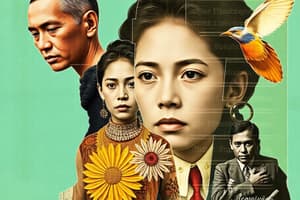Podcast
Questions and Answers
What is the term used to describe the native inhabitants of the Philippines?
What is the term used to describe the native inhabitants of the Philippines?
Indigenous Peoples
Which of the following is NOT a prominent indigenous group in the Philippines?
Which of the following is NOT a prominent indigenous group in the Philippines?
- Igorot
- Aeta
- Lumad
- Inuit (correct)
How many distinct ethnic groups are there among the Indigenous Peoples of the Philippines?
How many distinct ethnic groups are there among the Indigenous Peoples of the Philippines?
110 to 120
What is the Indigenous Peoples Rights Act (IPRA)?
What is the Indigenous Peoples Rights Act (IPRA)?
Which indigenous group is known for its traditional rice terraces?
Which indigenous group is known for its traditional rice terraces?
Indigenous groups in the Philippines are primarily located in urban areas.
Indigenous groups in the Philippines are primarily located in urban areas.
The ____ are known for their knowledge of forests and traditional healing.
The ____ are known for their knowledge of forests and traditional healing.
Which indigenous group is not found in Mindanao?
Which indigenous group is not found in Mindanao?
Flashcards are hidden until you start studying
Study Notes
Indigenous Peoples of the Philippines
- Indigenous Peoples (IPs) or Cultural Communities are native inhabitants preserving traditional ways of life, resisting assimilation into mainstream society.
- Approximately 110 to 120 distinct ethnic groups exist, each with unique languages, customs, and belief systems.
Prominent Indigenous Groups
- Aeta (Agta): Reside in Luzon mountains, known for traditional healing and a deep knowledge of forests.
- Igorot: Collective group from the Cordillera region, includes Bontoc, Kalinga, and Ifugao; recognized for UNESCO-listed rice terraces and strong tribal governance.
- Lumad: Indigenous groups in Mindanao, including Manobo and T’boli, noted for vibrant traditions and sustainable farming practices.
- Mangyan: Inhabit Mindoro, recognized for weaving, basketry, and the ancient "Surat Mangyan" writing system.
- Tagbanua: From Palawan, practice traditional farming and fishing, rooted in animist beliefs tied to sacred natural sites.
Marginalization and Legal Framework
- Indigenous communities have faced marginalization, with rights threatened by modernization, development, and land-grabbing.
- The Indigenous Peoples Rights Act (IPRA) of 1997 aimed to protect rights to self-determination, cultural integrity, and ancestral domains, though implementation remains inconsistent.
Cultural Diversity and Practices
- Indigenous cultures exhibit diverse religious beliefs, social structures, and artistic expressions, heavily influenced by animism and nature.
- Rituals and ceremonies are utilized for honoring spirits and ancestors, often governed by kinship-based systems with councils of elders or chieftains.
Regional Highlights
-
Luzon:
- Aeta: Bound to Zambales, Tarlac, and Pampanga; skilled in hunting and gathering, known for unique physical traits.
- Igorot: Notably skilled in crafting and known for traditional rice terraces.
-
Visayas:
- Ati (Panay Island): Celebrates the Ati-Atihan Festival, one of the oldest in the Philippines, highlighting cultural heritage.
- Waray-Waray (Samar and Leyte): Recognized for oral literature and dance traditions, showcasing resilience in natural disasters.
Cultural Resilience
- Indigenous communities maintain rich cultural identities through rituals, dances, music, oral traditions, and communal practices, contributing to the Philippines' national identity.
Studying That Suits You
Use AI to generate personalized quizzes and flashcards to suit your learning preferences.




